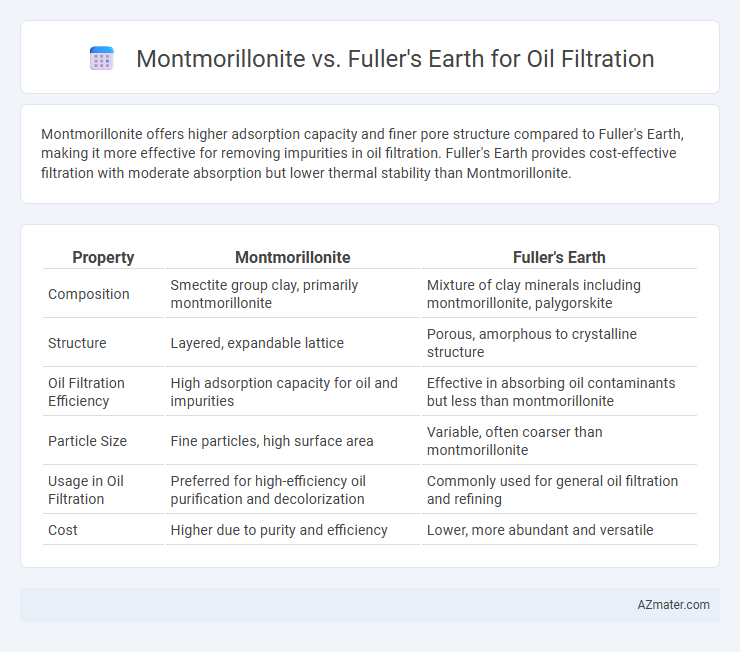Montmorillonite offers higher adsorption capacity and finer pore structure compared to Fuller's Earth, making it more effective for removing impurities in oil filtration. Fuller's Earth provides cost-effective filtration with moderate absorption but lower thermal stability than Montmorillonite.
Table of Comparison
| Property | Montmorillonite | Fuller's Earth |
|---|---|---|
| Composition | Smectite group clay, primarily montmorillonite | Mixture of clay minerals including montmorillonite, palygorskite |
| Structure | Layered, expandable lattice | Porous, amorphous to crystalline structure |
| Oil Filtration Efficiency | High adsorption capacity for oil and impurities | Effective in absorbing oil contaminants but less than montmorillonite |
| Particle Size | Fine particles, high surface area | Variable, often coarser than montmorillonite |
| Usage in Oil Filtration | Preferred for high-efficiency oil purification and decolorization | Commonly used for general oil filtration and refining |
| Cost | Higher due to purity and efficiency | Lower, more abundant and versatile |
Introduction to Oil Filtration
Oil filtration relies heavily on the adsorption properties of materials such as Montmorillonite and Fuller's Earth, both known for their high cation exchange capacity and surface area. Montmorillonite, a type of smectite clay, offers superior swelling properties and enhanced contaminant trapping efficiency, making it effective in removing impurities and heavy metals from crude oil. Fuller's Earth, composed primarily of palygorskite and attapulgite clays, excels in oil decolorization and viscosity reduction due to its unique fibrous structure and high porosity, optimizing the clarification process in oil refining.
What is Montmorillonite Clay?
Montmorillonite clay is a highly absorbent mineral composed of layered silicates, commonly found in bentonite clay deposits. Its unique structure allows it to trap impurities and chemicals effectively, making it ideal for oil filtration applications by removing contaminants and improving oil clarity. Compared to Fuller's Earth, Montmorillonite offers superior adsorptive capacity and thermal stability, enhancing filtration efficiency in industrial and environmental settings.
What is Fuller’s Earth?
Fuller's Earth is a highly absorbent clay material primarily composed of hydrous aluminum silicates, widely used in oil filtration for its ability to remove impurities, color, and odors from crude and lubricating oils. Its fine particle size and unique porous structure allow efficient adsorption of contaminants, making it superior in refining processes compared to similar clays like montmorillonite, which has a different mineral composition and lower adsorptive capacity. The effectiveness of Fuller's Earth in oil filtration depends on factors such as purification grade, activation method, and particle size distribution, optimizing its performance in industrial applications.
Chemical Composition: Montmorillonite vs Fuller’s Earth
Montmorillonite is a smectite group clay mineral primarily composed of hydrated aluminum silicate with a high cation exchange capacity, making it highly effective in adsorbing impurities in oil filtration. Fuller's Earth, often containing a mix of montmorillonite and other clay minerals such as kaolinite and bentonite, offers a varied chemical composition that influences its oil filtration efficiency and contaminant absorption. The distinct mineralogical differences between montmorillonite and Fuller's Earth affect their respective surface areas, porosity, and adsorption properties critical for targeted oil purification processes.
Filtration Efficiency: Performance Comparison
Montmorillonite exhibits superior adsorption capacity and particle retention due to its high cation exchange capacity and expansive surface area, making it highly effective in removing oil contaminants. Fuller's Earth, while effective in absorbing impurities, often shows lower filtration efficiency in fine particulate removal compared to Montmorillonite, attributed to its more limited surface activity. Studies indicate Montmorillonite's micro-porous structure enhances oil filtration performance, resulting in clearer filtrate and reduced oil content.
Oil Purity and Quality Results
Montmorillonite exhibits superior adsorption properties, effectively removing impurities and enhancing oil purity through its high cation exchange capacity and layered structure. Fuller's Earth also serves as an effective adsorbent but tends to have a broader particle size distribution, which may result in less consistent oil filtration and slightly lower oil quality outcomes. Comparative studies indicate Montmorillonite's finer filtration capabilities contribute to enhanced oil clarity, stability, and overall quality in industrial filtration processes.
Cost-Effectiveness and Availability
Montmorillonite offers a more cost-effective solution for oil filtration due to its widespread natural deposits and lower extraction costs compared to Fuller's Earth. Fuller's Earth, while highly absorbent and efficient in removing impurities, tends to be more expensive and less readily available in large quantities. Choosing Montmorillonite ensures a balance of affordability and accessibility, making it a preferred option for large-scale oil purification processes.
Environmental Impact and Sustainability
Montmorillonite and Fuller's Earth both serve as effective oil filtration agents with distinct environmental impacts; Montmorillonite is a naturally abundant clay mineral known for its high adsorption capacity and low environmental toxicity, making it a sustainable choice for oil spill remediation. Fuller's Earth, primarily composed of calcium bentonite, offers efficient oil absorption but often requires more energy-intensive processing, which can increase its carbon footprint compared to raw Montmorillonite. Sustainable oil filtration prioritizes the use of natural, minimally processed clays like Montmorillonite to reduce environmental disruption and support eco-friendly waste management practices.
Industrial Applications and Suitability
Montmorillonite is widely utilized in industrial oil filtration due to its high cation exchange capacity and superior adsorption properties, effectively removing impurities and moisture from lubricants and transformer oils. Fuller's Earth, with its porous structure and strong affinity for oils, excels in refining and bleaching applications but may have lower adsorption efficiency compared to Montmorillonite in heavy-duty filtration. Both clays offer distinct benefits, with Montmorillonite favored for continuous oil purification processes and Fuller's Earth preferred for batch refining in industrial settings.
Choosing the Right Clay: Key Factors to Consider
Choosing the right clay for oil filtration requires evaluating adsorption capacity, particle size distribution, and chemical composition, where Montmorillonite offers superior cation exchange capacity and swelling properties enhancing contaminant removal. Fuller's Earth, composed primarily of palygorskite and bentonite, provides strong oil absorption and excellent filtration due to its high porosity and surface area. Consider the specific oil type, contamination level, and filtration system compatibility to optimize efficiency and extend oil lifecycle.

Infographic: Montmorillonite vs Fuller’s Earth for Oil Filtration
 azmater.com
azmater.com